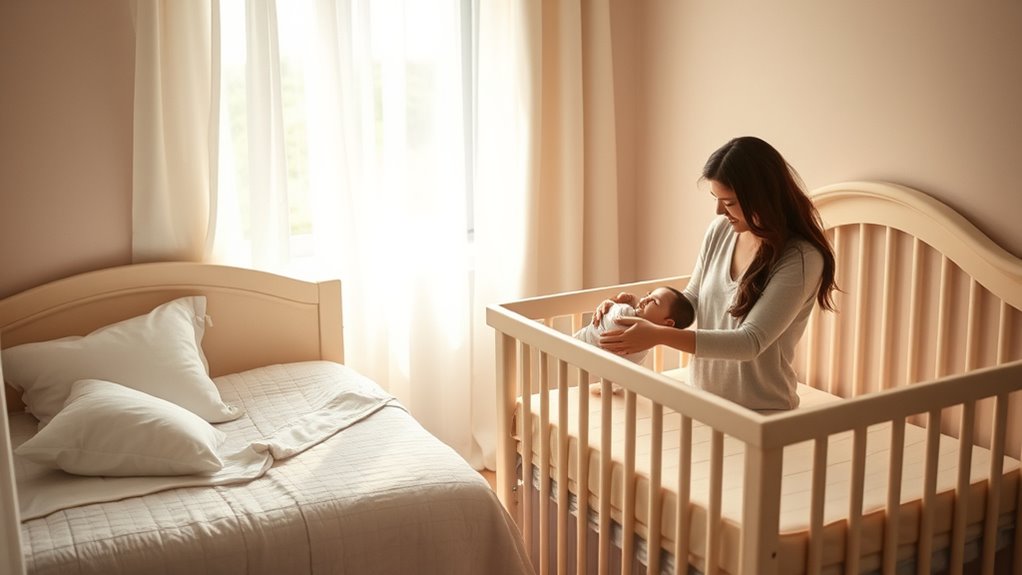To shift your baby from co-sleeping to a crib, start by creating a calm, inviting nursery with familiar objects like blankets or plush toys. Introduce the crib gradually by allowing your baby to nap there during the day and maintaining a consistent bedtime routine. Be patient as your baby adjusts, stick to gentle sleep training methods, and respond with reassurance when needed. If you keep consistent, you’ll help your little one feel secure and independent—there’s more to explore on this journey.
Key Takeaways
- Gradually introduce the crib during daytime naps to familiarize your baby with the new sleep space.
- Establish a consistent, calming bedtime routine to signal it’s time to sleep independently.
- Create a soothing environment with dim lighting, familiar objects, and minimal noise to promote comfort and security.
- Respond briefly to your baby’s cries, gradually increasing the time between comforting to encourage self-soothing.
- Practice patience and stay consistent, understanding that the transition may take days to weeks with some setbacks.

Moving your baby from co-sleeping to a crib can be a smooth process with the right approach. The key is establishing consistent bedtime routines and implementing gentle sleep training techniques that help your little one feel secure and comfortable. Start by creating a calming environment in the nursery. Dim the lights, remove any distracting noise, and use a favorite blanket or stuffed animal to make the space inviting. Before the transition, develop a predictable bedtime routine—perhaps a warm bath, a gentle story, and some cuddles. This signals to your baby that it’s time to wind down, making the shift to a different sleeping arrangement less startling.
Create a calming nursery environment and establish a predictable bedtime routine to ease the crib transition.
Once you’ve set the stage, begin introducing the crib gradually. You might start by having your baby nap in the crib during the day, so they get used to the new environment without the pressure of overnight sleep. During the initial nights, stay consistent with your sleep training techniques. If you’re using methods like the gradual retreat or pick-up-put-down, stick with them. These techniques promote independence while providing reassurance. For example, if your baby cries, give them a few moments to self-soothe before offering comfort, gradually increasing the time between interventions. This helps your baby learn to fall asleep on their own, making the transition less stressful over time.
Be prepared for some resistance initially. It’s normal for your baby to protest or wake up more frequently as they adjust. Patience is vital. Comfort your baby briefly if needed, but avoid creating a habit of staying until they fall asleep. Instead, reassure them with your voice or gentle touches, then leave the room once they’re calm. Consistency is essential; sticking to the same routine each night helps your baby develop a sense of predictability and security. Incorporating high-contrast visuals or familiar objects can also aid in creating a comforting environment that encourages sleep.
Throughout this process, keep in mind that every baby adjusts at their own pace. Some might take a few days, others a few weeks. If setbacks occur, don’t get discouraged. Reaffirm the routine, stay consistent with sleep training techniques, and give your baby time. Remember, the goal is to help your child feel safe and independent in their own space. With patience, a calm environment, and steady routines, transitioning from co-sleeping to a crib can become a manageable and even bonding experience, setting the foundation for better sleep habits in the future.
Frequently Asked Questions
When Is the Best Time to Start Transitioning?
The best time to start the shift depends on your baby’s development and sleep environment needs. Usually, around 6 to 12 months is ideal, as this allows your baby to adjust gradually. Pay attention to signs they’re ready, like reaching milestones or showing independence. Choose a consistent schedule, guarantee the sleep environment is safe and comfortable, and gradually introduce the crib to make the transition smoother.
How Do I Handle Nighttime Awakenings During the Transition?
When your baby wakes at night during the changeover, stay calm and stick to your sleep environment. Use soothing techniques like gentle patting or soft singing to comfort them without picking them up. Keep the room dark and quiet, helping your baby associate the space with sleep. Consistency is key—respond calmly and briefly each time, so your baby learns to settle back on their own.
What if My Baby Protests the Change?
If your baby protests the change, stay calm and use a gentle approach. You can make a gradual adjustment by introducing the crib gradually, perhaps starting with naps or placing it nearby initially. Comfort your baby and reassure them with soothing words and routines. Consistency helps, so stick to your new plan, and over time, your baby will adapt to the new sleeping environment.
Should I Use a Sleep Training Method?
Did you know that nearly 60% of parents find sleep training effective? When considering a gentle shift, using sleep training can help your baby adapt gradually to the crib. It encourages self-soothing and fosters healthy sleep habits. You should choose a method that feels right for you and your baby, and remember, consistency is key. A gentle approach can make the transition smoother, reducing protest and ensuring everyone gets better rest.
How Can I Maintain a Bonding Routine After the Move?
To maintain your bonding routine after moving your baby to a crib, keep bedtime special. You can read bedtime stories and offer gentle touch to reassure your little one. Stick to familiar routines to create a sense of security, and spend extra cuddling time during these moments. This consistency helps your baby feel loved and connected, even as you shift to the new sleeping arrangement.
Conclusion
Remember, shifting your baby from co-sleeping to a crib is a gradual process that builds trust and comfort. Think of it like planting a seed—patience and gentle care will help it grow into a strong, independent little one. Imagine a sunrise, slowly illuminating the sky—your baby will adjust at their own pace, and soon, they’ll be happily drifting off in their own cozy space. Trust the process; brighter days are just around the corner.









